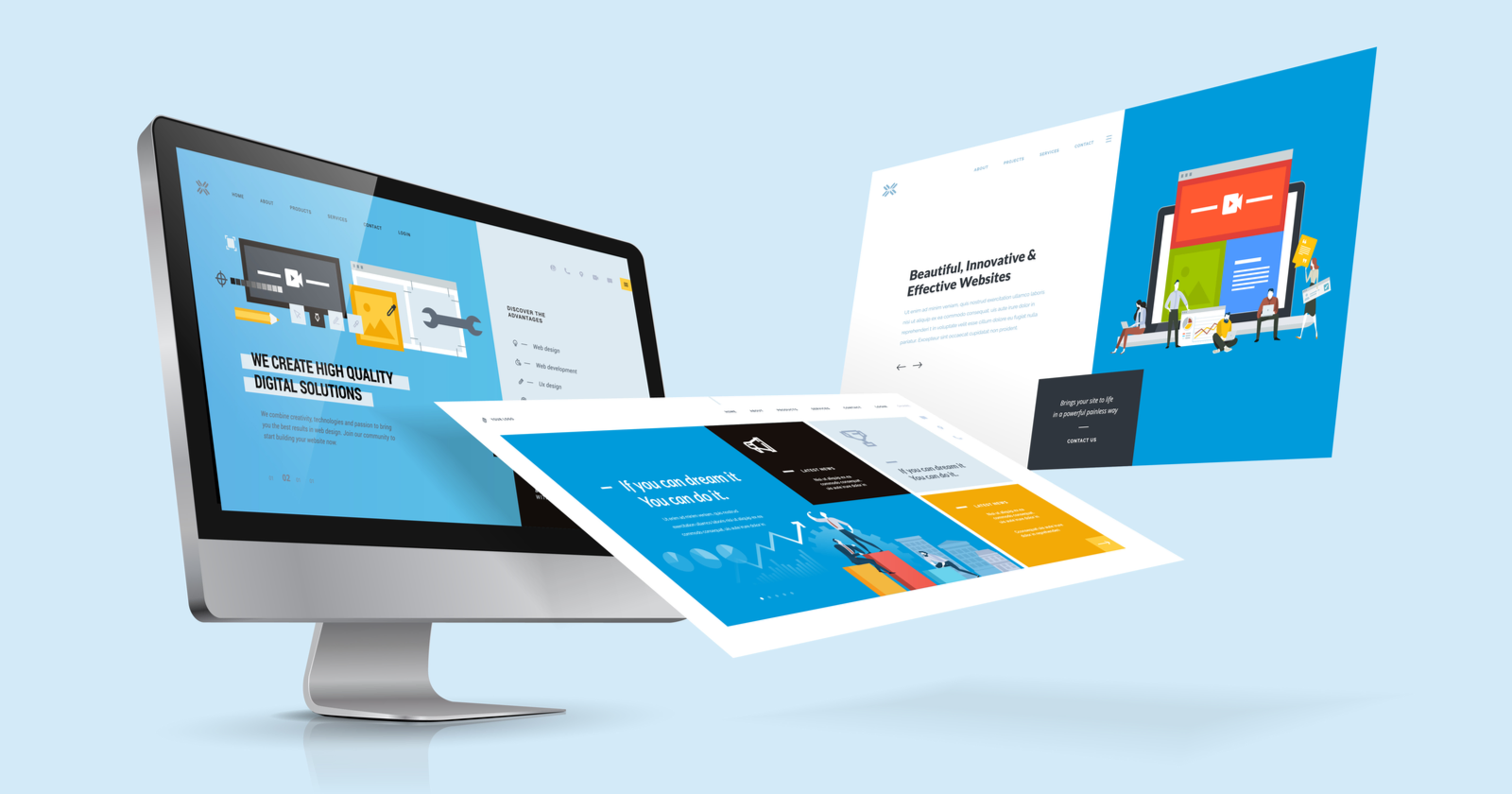Exactly How to Effectively Integrate Visual Appeals and Capability in Internet Design
When developing a website, you need to strike a balance in between aesthetics and functionality. It's not just concerning looking good; your design ought to likewise serve an objective and guide users efficiently. By concentrating on simpleness and user-friendly navigating, you can create an interesting experience. What elements truly improve functionality while preserving visual charm? Let's check out the vital concepts that can lead to an unified mix of elegance and function.
Comprehending the Significance of Aesthetics and Functionality
Recognizing the equilibrium between visual appeals and performance is vital for producing an effective customer experience when you create a web site. An aesthetically enticing site grabs interest, yet it's the functionality that keeps individuals involved. Visitors will promptly lose passion and leave.Consider your target audience and what draws them in if your site looks fantastic yet is challenging to browse. You intend to develop a style that reflects your brand name while guaranteeing convenience of use. Structured designs, intuitive navigating, and clear phone call to action can enhance both visual appeals and functionality.

Principles of Reliable Website Design
To produce an effective internet style, you require to follow numerous crucial principles that improve both user experience and aesthetic appeal. Initially, prioritize simpleness; a clean format helps customers navigate conveniently. Make use of a regular color system and typography to maintain comprehensibility across your site. This cultivates experience and trust.Next, guarantee your style is receptive. Users accessibility internet sites on various gadgets, so your layout ought to adjust perfectly. Take notice of visual hierarchy; emphasize crucial components with color, positioning, or dimension to assist users' focus.Finally, incorporate sufficient white space. It avoids mess and makes material extra absorbable. Remember, efficient internet layout equilibriums looks and functionality, so every layout selection should serve a purpose. By following these concepts, you'll develop a website that's not just aesthetically enticing yet also user-friendly, eventually keeping visitors engaged and motivating them to return.
Prioritizing Individual Experience
When focusing on individual experience, you'll desire to start by comprehending what your individuals genuinely need. Simplifying navigating design can make a substantial distinction in how conveniently they find what they're seeking. Also, boosting aesthetic power structure assists guide their attention to one of the most vital components on your website.
Understanding Customer Requirements
Understanding customer requirements is vital for creating an interesting web experience that maintains visitors returning. To accomplish this, you must determine the objectives and preferences of your target market. Begin by conducting individual research, like interviews or studies, to gather understandings on what users worth most. When connecting with similar web sites, pay interest to their discomfort points and obstacles. This information enables you to customize your design, ensuring performance straightens with user expectations. Furthermore, consider developing user personalities that stand for various segments of your target market, helping you picture their demands during the style procedure. When you focus on understanding user requirements, you produce a site that not just looks wonderful but also provides a seamless, delightful experience that fosters loyalty.
Simplifying Navigation Layout

Enhancing Visual Hierarchy
A strong aesthetic power structure is essential in leading customers with your site and guaranteeing they engage with vital web content. To accomplish this, use spacing, color, and dimension tactically. Make essential elements like headings bigger and bolder than body text, drawing interest promptly. Use contrasting colors to highlight calls to activity, urging clicks. Furthermore, utilize sufficient white room to separate areas, making material absorbable and inviting.Consider the flow of details; arrange elements practically, leading individuals' eyes from one point to the following. Use aesthetic hints, like lines or arrows, to direct focus. By prioritizing aesthetic pecking order, you boost user experience and raise the probability of conversions, ensuring your internet site is both visually pleasing and functionally reliable.
Color Concept and Its Influence On Functionality
While choosing the ideal colors for your web site might seem like a small information, it considerably influences functionality and customer experience. Color impacts just how users view information and can improve or prevent navigating. For example, contrasting colors can aid crucial components stand out, making it less complicated for visitors to find what they need.Additionally, think about the psychology of shades: blue commonly motivates count on, while red produces necessity. Recognizing your target market can lead your shade selections, ensuring they reverberate well.Moreover, constant color pattern assist develop brand name identification, making your internet site more memorable. However, be cautious-- too many colors can overwhelm users. Stick to a restricted palette that complements your content and keeps clarity.Incorporating accessibility is additionally necessary; confirm your color mixes are pleasant for those with aesthetic disabilities. By attentively applying color theory, you'll enhance usability and develop an extra appealing user experience.
Typography: Balancing Design and Readability
Shade choices established the stage for your web site, but typography plays a just as essential duty in boosting individual experience. You want your message to interact plainly while additionally showing your brand name's personality. Start by picking typefaces that are not only appealing yet additionally legible. Sans-serif fonts typically work well for electronic displays, as they're easier to review at various sizes.Maintain a hierarchy by utilizing different typeface sizes and weights; this overviews individuals via your content easily. Think about line spacing and letter spacing; also tight can discourage visitors, while also loosened can interrupt the circulation. Limitation your typeface choices to 2 or three to keep the style cohesive.Finally, constantly evaluate your typography throughout different gadgets and internet browsers. What looks great on one display might not on one more. Stabilizing style with readability assurances that your message reverberates, keeping your audience notified and involved.
Responsive Design: Making Aesthetic Appeals Work With All Devices
To ensure your web site looks terrific on any kind of device, you'll need to welcome responsive style concepts. This strategy guarantees your site adapts to different screen sizes, supplying an ideal individual experience. Begin by utilizing liquid grids and flexible pictures that scale flawlessly. As opposed to taken care of dimensions, go with percents and loved one units, enabling your design to change dynamically.Next, carry out media questions in your CSS. These allow you use various styles based on device qualities, like screen width. In this manner, you can preserve visual allure while assuring functionality.Don' t forget touch targets; ensure switches and web links are very easy to tap on smaller screens. Focus on important content, so users can easily navigate your website no matter their gadget. By concentrating on these elements, you'll create an engaging, aesthetically appealing experience that satisfies the requirements of all users, whether they get on a tablet, desktop, or smart device .
Performing Functionality Testing for Continuous Improvement
To boost your internet layout, you need to establish clear use objectives that align with customer requirements. By conducting customer tests, you can gather important feedback on just how actual individuals engage with your site. Analyzing these outcomes will aid you make educated renovations and produce an extra efficient user experience.
Specifying Usability Goals
While visual appeals can draw individuals in, defining functionality objectives is crucial for ensuring their experience remains smooth and rewarding. Beginning by identifying what you desire users to accomplish on your site (website design london Ontario). Consider their behaviors, requirements, and jobs. Are they trying to find information, purchasing, or registering for an e-newsletter? Establish clear criteria to gauge success, like task completion prices or time on job. Prioritize user-friendly navigating, obtainable material, and receptive layout to enhance functionality. Consistently revisit these goals as individual assumptions evolve. By defining functionality objectives, you develop a structure for evaluating and enhancing your internet site's efficiency. This concentrate on usability not only increases individual satisfaction but likewise strengthens the total performance of your layout
Performing User Examinations
Conducting user tests is important for improving your internet site and guaranteeing it fulfills your target market's requirements. Start by identifying your target users and creating a test plan that outlines your purposes. Use a mix of quantitative and qualitative methods, such as studies, meetings, and task-based monitorings, to gather extensive comments. Welcome participants to navigate your site while you observe their communications and note any problems they experience. Encourage open discussion to record their thoughts and feelings concerning the design and functionality. Maintain sessions brief and focused, guaranteeing you cover vital locations without overwhelming customers. Finally, see to it to document all searchings for, as this info will certainly be very useful for making educated design choices that improve both appearances and usability.
Evaluating Test Outcomes
How can you effectively assess the outcomes of your usability tests to drive continuous renovation? Start by classifying feedback right into usual themes. Look for patterns in individual actions that highlight pain factors or areas for enhancement. Usage quantitative information, like job completion prices and time on task, to determine usability fairly. Do not neglect to take into consideration qualitative insights from individual remarks; they commonly disclose underlying issues that numbers can't show. Focus on the most impactful findings and develop actionable products for your style group. Keep in mind, it's about iterating-- apply changes, then examination once more. This cycle of testing, assessing, and refining helps you balance aesthetic here appeals and capability, guaranteeing your website satisfies customer needs successfully while keeping aesthetic appeal.
Regularly Asked Inquiries
How Do I Choose the Right Color Combination for My Internet site?
To choose the right color combination for your web site, consider your brand name's personality, target audience, and emotional effect (website design london Ontario). Use color psychology, produce harmony, and assurance readability. Examination mixes to see what reverberates ideal with site visitors
What Devices Can Aid With Web Design Appearances and Functionality?
You can use tools like Adobe XD, Figma, and Sketch to enhance your website design's aesthetic appeals and capability. These systems supply instinctive user interfaces, cooperation attributes, and pre-made layouts to simplify your creative procedure and improve your layouts.
Just How Can I Include Animations Without Endangering Functionality?
To include animations without compromising capability, focus on subtle impacts that boost user experience. Use CSS computer animations for smoother communications, assurance quick tons times, and test on various tools to preserve performance while including aesthetic appeal.
What Are Common Blunders to Prevent in Website Design Aesthetic Appeals?
When making, prevent cluttered formats, inadequate color options, and irregular typefaces. Do not neglect mobile responsiveness, as it can push away individuals. Verify your style aligns with your brand, developing a smooth experience that engages visitors properly.
Exactly how Commonly Should I Update My Site's Design for Ideal Aesthetic Appeals?
You should upgrade your website's design every 1-2 years to keep up with fads and maintain ideal looks. On a regular basis renewing visuals aids involve warranties and visitors your website stays attractive and easy to use. When you design an internet site, understanding the equilibrium between visual appeals and functionality is necessary for developing an efficient customer experience. To produce an efficient web design, you need to stick to numerous crucial concepts that enhance both customer experience and visual allure. Users access sites on different devices, so your layout ought to adapt perfectly. When focusing on individual experience, you'll want to begin by comprehending what your customers really require. Begin by carrying out user research study, like meetings or surveys, to collect understandings on what users value most.